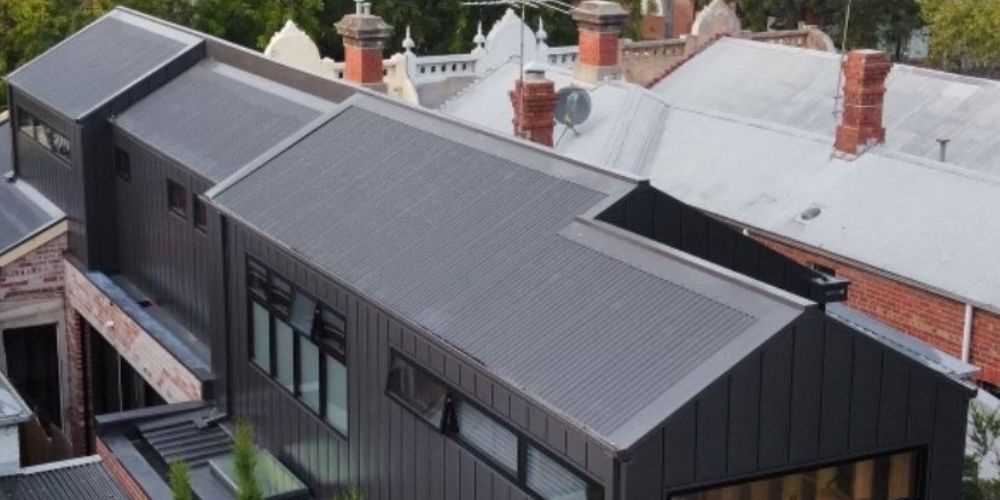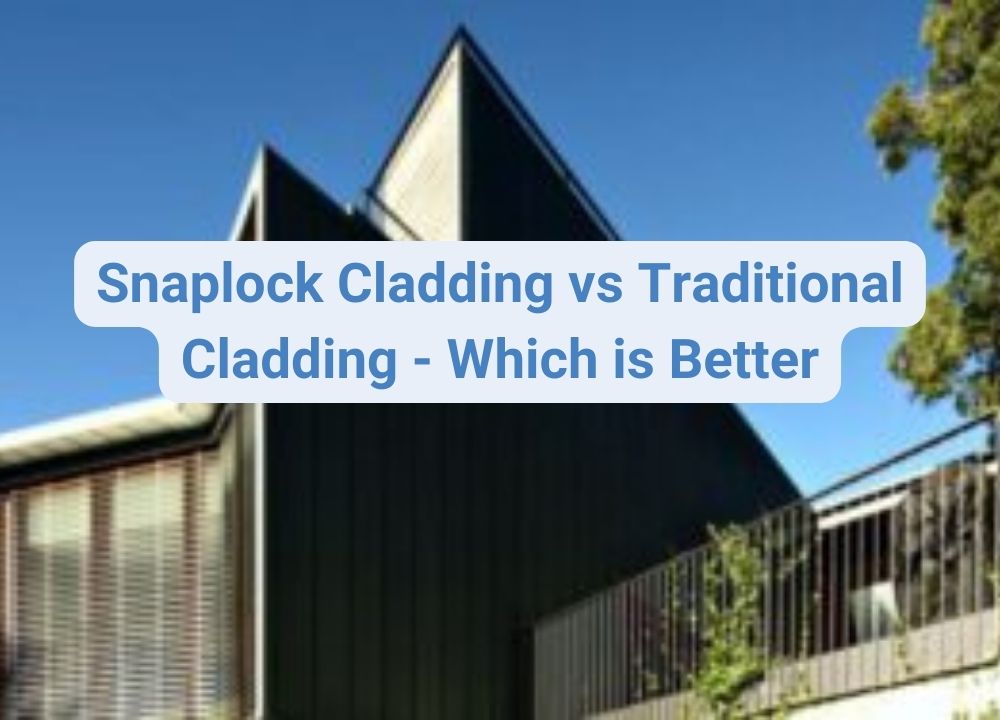Snaplock Cladding vs Traditional Cladding - Which is Better?
Standing seams have been replaced with Snaplock more recently. Thanks to a simple and inexpensive installation procedure, this system takes less time and costs less. Snaplock cladding allows for a more professional installation without needing specialised equipment, making it a favourite profile for roofing and walling among builders and architects.
One of the most popular and straightforward to install cladding kinds is Snaplock. Choosing one that would suit your needs should be simple because they come in various colours, textures, and designs.
Have you seen the term “snaplock cladding” tossed around and wondered what it meant? You’re not alone, we’ve all heard of it, but do we know what it is? Let’s take a look.

Lance Mathews
In This Article

What is a Snaplock Cladding?
A metal roofing system with snaplock cladding is created to be simple to install and maintain. The cladding system’s snap-together panels do not require mechanical fasteners, lowering the possibility of leakage.
Although it may be used for residential roofing, this cladding is frequently used for commercial and industrial structures. The panels may be found in several colours and finishes to complement the style of the structure and are often manufactured from materials like steel, aluminium, or copper.
What Makes Snaplock Cladding Unique
With the help of the recent invention in the building sector known as Snaplock Cladding, you may swiftly and efficiently construct your home.
Snaplock are sturdy, long-lasting, and lightweight, was used to make it. You don’t have to be concerned about it deteriorating or chipping away while installing it on the exterior of your home.
Moreover, Snaplock Cladding has a unique locking mechanism that keeps the panels firmly fastened even in inclement weather like wind and rain.
Additional characteristics are:
- Exquisite finish that looks fantastic whether it is being used for domestic or business uses.
- It has a lifetime guarantee, so you won’t have to worry about it deteriorating at any moment (even if there are kids around).
- It can be used on commercial and residential projects.
- Lightweight cladding with a vertical and horizontal pattern
- An attractive vertical fin
- Simple substitute for the standing technique
- You may order curved system systems.
- Little maintenance is required.
- Economical
- Available following fire rating standards
Pros and Cons of Snaplock Cladding
Snaplock cladding is a popular choice for homeowners who wish to give their property a more modern appearance. Nevertheless, it is not the ideal choice for all buildings because there are various advantages and disadvantages to consider before installing this cladding.
Pros
Weather-tightness
Snap Lock standing seam panels are fastened to the panel via clips. This removes any screws that might lead to leaks in the future. A mechanically seamed roof is superior since it is more firmly fastened, especially when doubly locked.
Low maintenance is needed
Since Snaplock cladding is made to survive all weather conditions, it doesn’t require the same degree of care as other varieties of panels. Your property won’t need to be painted or replaced with any components since they will continue to look fantastic without any upkeep.
Visually appealing
Snaplock cladding creates a unique appearance that stands out from other types of cladding. It is great to create designs that range from simple to elaborate in nature, giving you plenty of options when considering the appearance of your building or home.
Easily Installed
This roofing system comprises snap-together panels, just as the names suggest. Your roof’s installation procedure is made simpler and quicker by doing away with mechanical seams. All standing seam panels are challenging, and DIY installation is not usually advised. It is easier to install this panel than a mechanically seamed panel, though, if you want to try to do it yourself.
Efficiency in energy
Because Snaplock is an energy-efficient coating, you may contribute to lower energy costs. This is so that the snaplock panels can store heat throughout the winter and then release it when the weather warms up since they have a high thermal mass. By doing this, you may reduce your heating costs during the winter.
Lightweight
Even though your home’s roof is built to support a lot of weight, going with something lighter can benefit your house in many ways. When seeking roofing alternatives that would put a minor strain on their home’s structure, homeowners frequently choose lightweight roofing options. For roofing contractors, lighter roofing materials are also simpler to handle, transport, and install.
Cons
Still expensive compared to other cladding
Although installing Snap Lock is less expensive than installing a mechanically seamed roofing panel, it is still expensive. It takes a lot of work to install and is constructed of the best materials. It will cost you around twice as much as a corrugated metal roof or an asphalt shingle roof. If you have the money, it’s less expensive in the long term if you can get beyond the first price shock. A standing seam metal roof will significantly reduce your long-term costs.
Noise
If your home’s roof is improperly insulated, noises can readily travel from the roof to the interior of your home. When selecting a roofing material for your home, be aware that a standing seam metal roof can be particularly noisy during rain or storms and that you must consider it or appropriately insulate your property.
At periods of heavy rain or hail, snaplock cladding might make noise. Installing insulation or employing a soundproofing substance, however, might lessen this.
Not Recommended For Low-Sloped Roofs
Snap Lock is not the best roofing material if your roof is level or has a minimal slope. These panels cannot be utilised on roofs with pitches lower than 3:12. This is because lower-sloping roofs are more likely to leak. The preferable option is a mechanically fixed standing seam if your roof has a pitch of 1:12 or higher.
Snaplock Cladding vs other types of Cladding- Which is Better?
Due to its simplicity of installation, robustness, and aesthetic appeal, snaplock cladding is a form of metal roofing and wall cladding system that is gaining popularity. It is constructed of snap-together interlocking panels that form a weather-tight seal to shield the structure from the elements.
Snaplock cladding is less complicated and takes less time to install than other forms of cladding, such as conventional standing seam metal roofing. Furthermore, many architects and designers like its clean, contemporary appearance.
Snaplock cladding may be used on every structure, location, and environment. It is also incredibly flexible. This makes it the perfect choice for people seeking an external cladding solution that requires no maintenance.
It may help you save a lot of money in the long term because it is also incredibly cost-effective. This is because you won’t need to pay for repairs or replacements as frequently as you would if you were using cladding made of metal or concrete.
Frequently Asked Questions
A Snap Lock standing seam system, including supplies and installation, ranges from $10 to $16 per square foot.
Snaplock panels are made to “snap” together, making installation simple. 25 mm rib height (from base to rib top); 225 mm, 325 mm, and 525 mm cost-effective panel widths, rib to rib; and up to 9000 mm long panels. These measurements are dependent on the kind of material and the mode of transportation and may be altered.
Each panel should run consistently from the eave at the bottom of the roof up to the ridge. The water tightness of properly placed panels should not be compromised by horizontal overlap.
Another prevalent form of standing seam panel profile is the snaplock panel profile. Moreover, they are roll-formed into shape using a male and female limb that snaps together in-plant or portable roll former. Unlike mechanical lock profiles, this profile does not need a seaming tool to join the panel legs.
Key Takeaways
Snaplock cladding is a great way to protect your home and increase curb appeal. It’s easy to install and can be painted or stained to blend in with the rest of the house.
Snaplock cladding is an excellent choice for adding extra protection from the elements without sacrificing curb appeal. It’s easy to install, versatile in colour, and comes in various textures.
Your home can benefit greatly from the addition of snaplock cladding’s style and appearance. Also, it makes it simple to fix and swap out damaged panels, saving you money on maintenance and replacement expenses. Snaplock cladding is a fantastic choice to add aesthetic appeal to your house.

